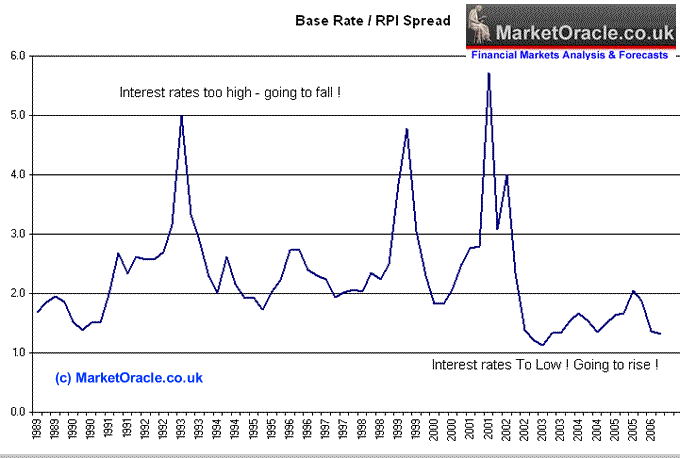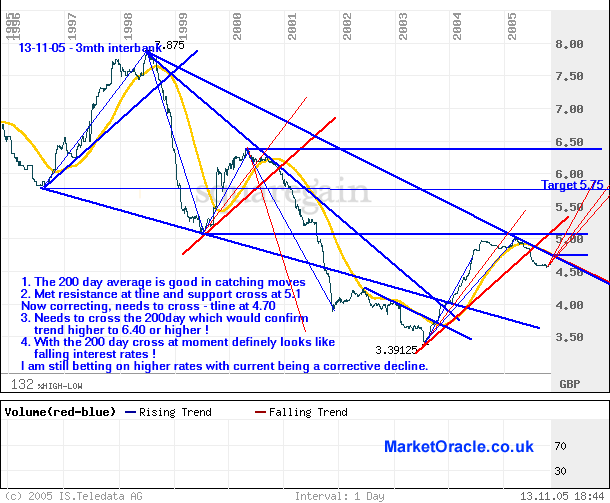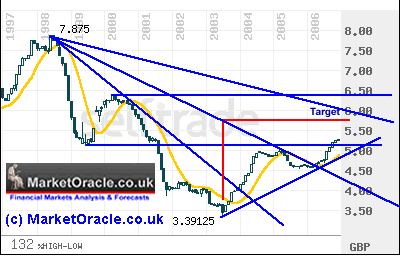UK Interest Rates could rise to 5.75% in 2007
Interest-Rates / UK Interest Rates Nov 07, 2006 - 05:12 AM GMTBy: Nadeem_Walayat
With this Thursdays BoE decision of a rise in interest rates to 5% a near certainty. There are clear signs that rates could carry on rising to much higher levels during 2007, due to rising inflation, fed by strong growth in the UK's Money Supply. The projection of 5.75% was first forecast by the Market Oracle in November 2005, with subsquent economic data confirming the trend in higher interest rates. Inflation as measured by CPI is currently running at 2.4% with RPI at 3.6%, well above the old cap of 3%, with little signs of abating despite the rate rises todate.
The spread between the base rate (4.75%) and RPI (3.6%), is currently at 1.3%, marginally higher than the low set in 2003 of 1.1%, which preceded a rise in interest rates from 3.5% to 4.75%. This took the spread to 2%, since that time, RPI has risen and interest rates have fallen to 4.5%. This puts the UK under similar interest rate hike pressures as during the start of the rate hikes back in 2003 and targets an interest rate rise to 5.75%.

For each 0.25% rate rise economic growth is likely to slow by 0.3%, thus a rise to 5.75% would imply a reduction in forecast GDP growth from the current 2.6% to 1.6%, which means that the UK is still likely to avoid a recession during 2007.
Other factors influencing rate rises towards 5.75% during 2007 are -
House Prices - Against BoE expectations, House prices have started to accelerate higher, and or now on target to achieve year on year growth of 10%, this despite the rate rises since 2003. The growth brings average house prices up to£169,623. With
data from the BoE showing the number of mortgage approvals -- seen as a gauge of future demand, rising to 126,000 in September, which is the highest level of activity in over two and a half years.
UK Money Supply - The
BoE data shows that M4 money, a broad measure of money supply, is rising at its fastest rate in 16 years on which will ensure higher inflation over the medium term.
M4 rose at an annualised rate of 14.5%, the biggest rise since September 1990.
The Money Markets - are already looking to the next rate rise after this months, with the implied rate for March 2007 at 5.42 percent, which is up from 5.19 percent at the start of September 06.
Related Articles© 2005-2022 http://www.MarketOracle.co.uk - The Market Oracle is a FREE Daily Financial Markets Analysis & Forecasting online publication.
Comments
|
RK1001
09 May 07, 01:32 |
Your interest rate forecast seems to be coming true. Any update on what to expect after UK rates hit 5.75% ? i.e. during the rest of the year ? |
|
Graham
09 Oct 08, 14:11 |
Required Information
Can i ask how u forecast this interest rate? eg, model etc. Hope u can help |
|
Nadeem_Walayat
09 Oct 08, 22:34 |
Interest rates forecast 2007 - 5.75%
The forecast was as a consequence of a series of articles over the preceding 12 months as listed above (see analysis). i.e. the graph from November 2005, which initially forecast the peak to 5.75% in terms of juncture, following the Bank of England's resolution of its sideways trend at the cost of future inflation.
However as the site has grown and become much more popular, I have gradually committed more of my time to writing articles and thus changed my style of writing over the years to include more relevant and updated analysis within the analysis / forecast articles, rather than relying on link backs to the preceding articles. Though the problem now is that it takes as long as a week to write a single substantial article, rather than the couple of hours that the above would have taken which relies on link backs to preceding analysis to elaborate on the reasoning behind the conclusion. In the case of the 2007 forecast I also refer you to the December 2006 article - UK Interest Rate forecast for 2007 - Bank of England to do battle with inflation, which contained an update of the above chart following resolution to the BOE's mistake to keep interest rates on hold which has resulted in much higher subsequent inflation as the above article correctly surmised.
Therefore analysis and forecasts are accumulative, built upon ongoing interpretation and trend analysis across a wide range of influencing inter-markets and economic indicators rather then relying upon a single eureka moment. Best. NW. |
|
Ashley White
14 Oct 08, 09:59 |
Please Help
Hi, Iam currently doing a university project on forecasting interest rates. I was wondering if you could suggest around 3 forecasting models i could use along previous data to help me compare the the difference. Much apreciated if you can help in anyway. Ashley |
|
Nadeem_Walayat
14 Oct 08, 10:25 |
Trade Interest Rate Futures to Know How to forecast Interest Rates
The real world does not work as theory implies how it should, the text books and economic theory as great theoreticians such as Bernanke are finding out. Each time period is different and requires differing inputs to determine forward interest rates due to the overall state of the markets, economy, inter-market relationships. I guess the most important consideration in being able to determine forward interest rates is by actually being immersed within the markets i.e. having exposure to interest rate sensitive investments such as derivatives, bonds etc... As without having money on the line that 'edge' will be missing that allows one to slice through the theoretical In summary - there is no one magical model, each time period is different, hence the current period's model is more market sentiment sensitive and hence completely opposite to economic models, as there is a need for deep interest rate cuts now, despite surging inflation as per the interest rate forecast for 2009. Good luck, but you won’t find the answer in an economics book that is why the Bank of England’s 2 year inflation forecast is consistently wrong, i.e. the Bank of England has only hit its target in 5 months out of 5 years, and thus the degree of interest rate volatility when inflation is supposed to be the primary determinant for interest rates. Therefore if the economists cannot model inflation forecasts accurately then they do not stand a hope in hells chance of modelling interest rates. As if you weight your forcast to one component whilst not incorporating perhaps more important real-world inputs then it is much more important that the inflation analysis is accurate. Whereas if you utilise and accurately analyse multiple inputs such as the exchange rate, house prices, stock prices, then the importance of accuract on inflation is less important as it is 1 of 4 contributing to the overall forecast trend. And TREND is an important determinaned therefore you do need to learn technical analysis as that also applies to be able to interpret chart patterns. |





